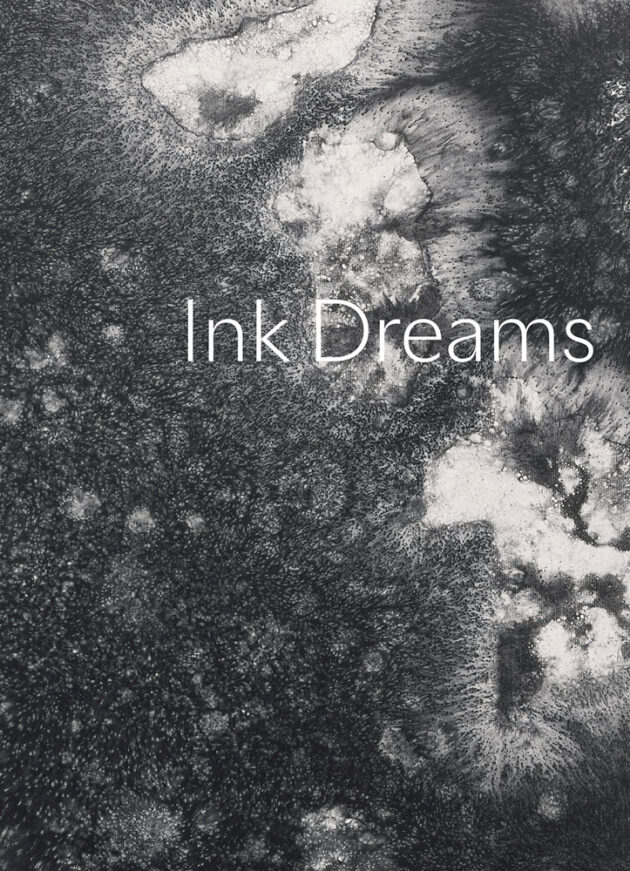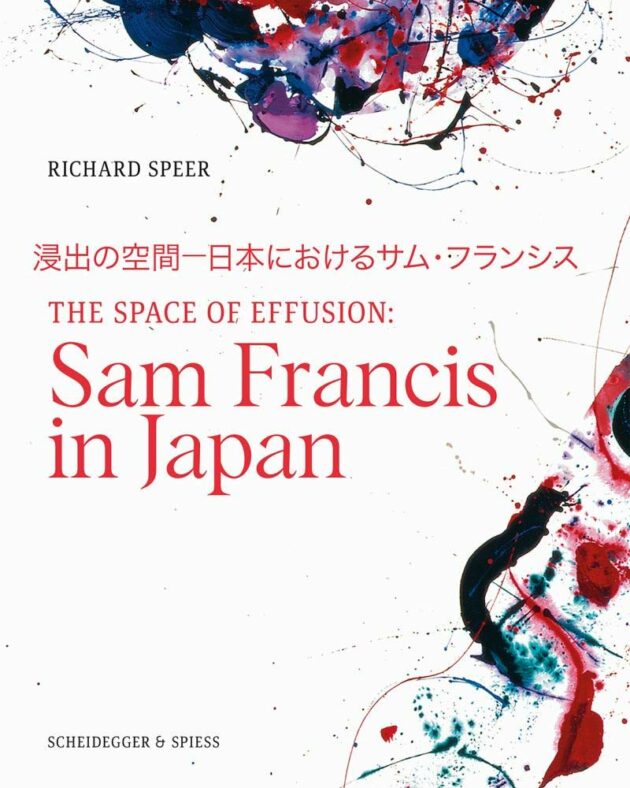Ink Dreams: Selections from the Fondation INK Collection. Susanna Ferrell, ed. (Los Angeles County Museum of Art / DelMonico Books/D.A.P, 2021) 256 pages.
The Space of Effusion: Sam Francis in Japan by Richard Speer. Edited by Debra Burchett-Lere. (Scheidegger & Spiess, 2020) 244 pages.
“We don’t mean that nothingness!” the Zen monk replied kindly when I described my understanding of the aim of rigorous wall-facing zazen practice. My Western mind wanted to know if I understood ma. “Please return to the cushion and continue.”
Void and emptiness continue to be on my mind, especially during the recent prolonged COVID pandemic period. Those little “fuzzy golf balls with tees jutting out,” the invisible enemy, were lurking literally everywhere… but exactly where? Void are spaces we once occupied without thinking: supermarkets, houses of worship and museums to airports, schools, offices and entertainment venues. Shelves in brick-and-mortar stores are empty of essential merchandise due to supply chain disruptions. Public transport vehicles travel from here to there and back void of passengers. Not full of nothingness, however, are hospitals, cemeteries and patience.
Ma is a favorite topic of Kyoto Journal contributors[i]. The two books under review, companions to site-specific exhibitions presented by the Los Angeles County Museum of Art (LACMA), are overflowing with ma in reproductions of 20th-21st artworks created by artists from East Asia and beyond in a variety of media. The two beautifully printed, these large-format full-color volumes include essays by art historians, curators and other scholars, as well as in-depth artists’ biographies and a sense of the dynamic cross-cultural milieux in which they lived.

INK Dreams, edited by LACMA’s Curator of Chinese Contemporary Art Susanna Ferrell, focuses on the more than 50 contemporary artists assembled from the INK Fondation, the collection of Gerard and Dora Cognie of Geneva, Switzerland. Through thoughtful text and large-format reproductions, we are given a chance to expand the definition of “ink” art beyond traditional carbon-based media applied by brush on paper, silk, etc.
Dr. Steven Little, the exhibition curator, reflects in his essay on “the astonishing degree to which the ancient art of Chinese ink painting has evolved over time and is relevant in the present world far beyond the imagined territory of China.” The artists whose work is included are: Bingyi, Gu Wenda, Li Huasheng, Li Huayi, Chen Haiyan, Lin Tianmiao, Liu Dan, Liu Guosong, Lui Shou-kwan, Qiu Shihua, Idris Khan, Wang Tiande, Wucius Wong, Xu Bing, Yang Jiechang, Zhang Yu, Zheng Chongbin, Park Seo-bo, Lee Ufan, Kitamura Junko, Kim Ho-deuk, Shirazeh Houshiary, Jorma Puranen, Matti Kujasalo, Ophélie Asch, Irma Blank, Michael Cherney, Shi Guorui, Hai Bo, Hiroshi Sugimoto and Min Byung Hun.
Editor Susanna Ferrell’s chapters explore the exhibition’s three themes: “Meditations: Centuries of Prolonging” include works reflective of the historic Buddhist canon and contemporary art. “Apparitions: Presence through Absence” includes the historical practice of wanglianghua, designated apparition painting”, “phantom mist” and “layering.” “Dreamscapes: Landscapes of the Heart” include the literati of the Song Dynasty and contemporary landscape artist. There is a biography of each artist.
Reading INK Dreams prepped me to encounter the Japan-inspired art of American abstract expressionist Sam Francis (1923–1994). Unlike most of the INK artists who used surfaces to contain images that draw one deeply beyond the field, The Space of Effusion: Sam Francis in Japan[LWD1] [DC2] explores how the Los Angeles-based artist vaults the viewer up and off the bright visual void of the planar surfaces. Francis packs in as much ma as possible, defying the limits of his canvases, tickling the mind with distracting splashes of vivid colors.

The Space of Effusion is in many ways as monumental as the American abstract expressionist artist’s work. The large-format full-color volume complements the exhibition Sam Francis and Japan: Emptiness Overflowing[ii] and is authored by the show’s independent curator Richard Speer. It also contains articles by LACMA co-curators Hollis Goodall (curator, Department of Japanese Art), and Leslie Jones (associate curator, Department of Prints and Drawings) reconsidering the work of other 20th century Western modernists. Generously laid out reproductions of artworks allow readers significant mind space to encounter the grandeur of the minimalist images. Debra Burchett-Lere, executive director of the Sam Francis Foundation in Pasadena CA, has penned the forward Sam Francis, a “Colorful Unsui.”
Two main sections include an analysis of the ma of the “Contested Void” and provide important information about othe major avant garde 20th century Asian-inspired artists, architects and aesthetic movements, as well as the artists who inspired and were influenced by Francis.
Sam Francis spent his life dwelling within and escaping from the limitations of formal boundaries. His earliest forays into “space” was training as a US Army Air Corps pilot, a long-held passion cut short by a life-threatening illness. Permanently disabled and thus grounded, he developed an affinity for aeronautical landscape photography. He began painting as therapy while being in a body cast and traction face down over his hospital bed for more than 2 years in the mid-1940s. Like Frida Kahlo, who also was confined to bed (facing upward) after a lengthy life-threatening illness and accident, Francis conflated life, death and painting, “When he recovered, he was convinced he had cured himself through art.”[iii]
As his work was growing in esteem throughout the world’s major art centers, including New York City, it was in Paris where he first connected, collaborated with and influenced a cross-section of expat Japanese colleagues, including Imai Toshimitsu and Dōmoto Hisao. According to author Richard Speer,
Through a charmed symbiosis of shared aesthetic motifs, overlapping philosophical concerns, easy personal rapports (sic), and mutually beneficial interests in the commercial realm, Francis and a core group of Japanese artists, writers, composers, architects and filmmakers found one another kindred spirits who would nurture each other’s creativity for the duration of their lives.
In 1955 his work was shown in a group exhibition at the Tokyo Metropolitan Art Museum to great acclaim.
Francis’ first trip to Japan was in 1957 when he was commissioned to create a multi-colored mural for the lecture hall of the Sogetsu ikebana school headed by Teshigahara Sofu, a project he completed in just two months. He returned to the USA, but clearly missed his bon vivant Tokyo life. So, he returned to Japan in 1960 for the first of many extended periods throughout his life. His artist friends, including members of the multi-media Gutai group, were all too happy to tutor him in overarching tenets of East Asian art, and he began to collect traditional pottery, paintings and Edo-Period makura-e, erotic “pillow pictures.” Sam was “Turning Japanese!”
Francis watched Zen monks painting in the hatsuboku style of splashed ink, a technique with similarities to his own style and that of contemporary Jackson Pollock. Consensus was that Francis’ “idiomatic handling of negative space” belied his American abstract expressionist bent. Consensus was the artworks were created by a Japanese!
Speer describes Francis’s earliest works in Japan as having “serene spaciousness,” and others as “echoing the negative space traversing important Japanese screens of the late 18th – early 19th century.” Gabrielle Selz, author of Light on Fire The Art and Life of Sam Francis, describes that imagery as “flat, moving more and more towards horizontal configurations where colors were set in undifferentiated space.” Negative space continued to define Francis’s stylistic fingerprint along with “bold color and exuberant gesture.” In a companion document published online Speer states,[iv] Francis’s work was celebrated [in 1974] by Japanese poet Ooka Makoto in Dreaming Sam Francis in which the painter was envisioned “in the clouds amid a deluge in which ‘all was whiteness floating.” The founder of the renshi poetry movement, Ooka alludes to the artist’s “heightened emphasis on ground rather than figure … the whitespace of the canvas shines.”
Ooka was being quite literal! In 1966, Francis had released tinted smoke over Tokyo Bay from a helicopter. The following year the artist had created an effusion of colors from flares released over a pristine snow-covered Japan ski slope. In response to Ooka, Francis is reported to have proclaimed: “My white is a painted white.There’s white because there’s red. The white has been put there.”
In addition to Gutai, Francis was connected with the political and aesthetic Mono-ha (the “School of Things”) movement of the late 1960s and early 1970s, whose members were actively opposed to the US involvement in Vietnam and promoted civil rights, free speech and freedom of assembly. He also was connected to Fluxus, as were Joseph Beuys, Dick Higgins, Alice Hutchins, Yoko Ono, Nam June Paik, Yayoi Kusama, Merce Cunningham, John Cage, Allan Kaprow, and many others. Speer argues that “Francis’s preoccupation with negative space during this period reached its apotheosis with his “Edge” paintings in which … ma metastasizes until it pushes forms and color to the very sides of the picture plane.” Francis explained, “The center of these paintings is reserved for you.”
[i]Kyoto Journal’s recent articles have included May 16, 2018 https://www.kyotojournal.org/culture-arts/ma-place-space-void/ and #98 (“MA: A Measure of Infinity”, https://www.kyotojournal.org/product/kyoto-journal-issue-98-ma-digital/). Also see our feature on the waterfall paintings of Hiroshi Senju in KJ #101.
[ii] The COVID – pandemic postponed exhibition Sam Francis and Japan: Emptiness Overflowing, will be presented at LACMA during Spring 2023.
[iii] Gabrielle Selz’s Light on Fire: The Art of Sam Francis (University of California Press, 2021) provides a timely, thorough biography as a companion to the art book. Selz met Francis in the early 1970s around the time when her late father, Peter Selz, the former director of MoMA, wrote a monograph about the artist. Her more recent research, however, revealed that much of the earlier personal information about Francis was false, perhaps due to the artist’s being a fabricator of “trickster personality”. Gabrielle Selz states, “Like the art he created, Sam’s life was a profound act of mythmaking and self-transformation.”
[iv] Cross-Cultural Expression in the Work of Sam Francis and Other Postwar Artists at LACMA https://samfrancis.lacma.org



